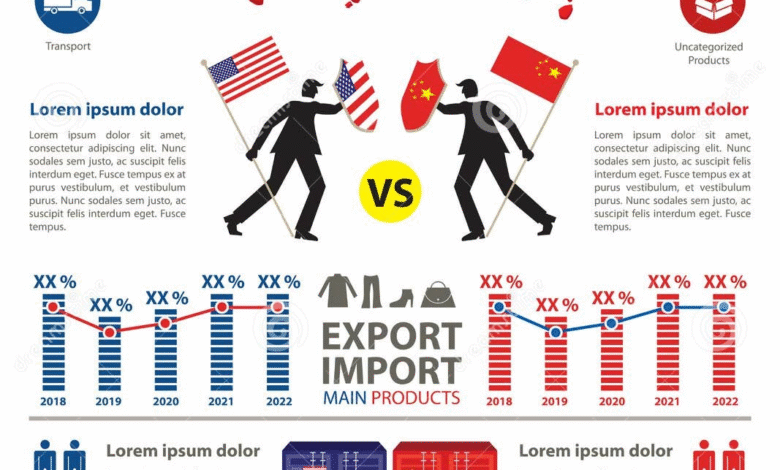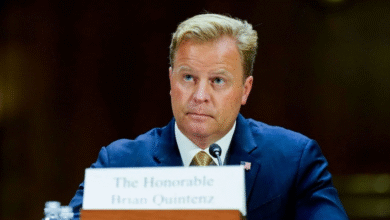US-China Trade Framework: A New Consensus Emerges

The U.S.-China trade framework has emerged as a pivotal development in international economic relations, following extensive negotiations aimed at stabilizing trade tensions between the two nations. With high-level discussions taking place in London, both sides are now seeking approval from their respective presidents to implement this new structure. This framework is designed to adhere to the previously established Geneva trade agreement and has the potential to reshape the tariff environment, including U.S. China tariffs, which have caused significant disruptions. Recent talks also hinted at addressing sensitive issues such as China’s rare-earth exports, which are critical to various industries. As the U.S. and China continue to navigate intricate negotiations, the implications of this trade framework may extend far beyond immediate economic gains, influencing global trade dynamics for years to come.
In the realm of global commerce, the U.S.-China trade framework represents a strategic response to escalating tensions between these two economic giants. This newly proposed structure aims to implement prior agreements made at the Geneva trade conference, focusing on resolving disputes related to tariffs and enhancing cooperation in critical sectors. The ongoing U.S. China negotiations showcase a critical effort to stabilize trade flows and address contentious topics such as rare-earth exports, which are essential for various technological applications. As both countries engage in trade talks in London, the draft agreement reflects a cautious but optimistic approach to fostering long-term bilateral trust and collaboration. Ultimately, this trade agreement could alter the landscape of international trade relations significantly.
The U.S.-China Trade Framework: A New Consensus
The recently established U.S.-China trade framework represents a significant milestone in international trade relations, marking a shift towards stability after a tumultuous period of tariff escalations. This new consensus, reached during high-level discussions in London, illustrates how both nations have prioritized dialogue over discord. The negotiators’ efforts culminated in an agreement that pauses new tariffs, allowing for a more structured approach to resolving ongoing disputes and establishing a more predictable trade environment. The framework is set to be presented to both President Trump and President Xi Jinping for their endorsements, potentially paving the way for a cooperative future in trade.
Key elements of this framework include commitments to uphold the Geneva trade agreement, which provides a foundation for future trade negotiations. The discussions, sparked by a 90-day suspension of tariffs, reflect a broader desire to reset the U.S.-China trade relationship. Negotiators from both sides have expressed optimism about resolving contentious issues such as China’s restrictions on rare-earth exports. This framework not only represents a consensus but also signals a willingness to engage in comprehensive talks aimed at addressing the foundational concerns of both economies.
Impact of Geneva Trade Agreement on U.S.-China Relations
The Geneva trade agreement has been pivotal in shaping the current landscape of U.S.-China trade negotiations. This agreement emphasizes the importance of collaborative enforcement of trade practices while addressing the ongoing concerns surrounding tariffs. As representatives from both nations work to navigate the complexities introduced during earlier negotiations, the framework aims to restore trust that has waned over multiple rounds of talks. The recent suspension of tariffs serves as a critical tool for both sides as they seek to bolster trade without unnecessary economic strain.
Moreover, the Geneva trade agreement’s principles encourage transparency and stability, which have been particularly significant amidst the backdrop of rising tensions. By agreeing to uphold its tenets, the U.S. and China signal their commitment to de-escalating a trade war that has had far-reaching consequences on global markets. Enhanced cooperation around the enforcement of trade rules could lead to a more substantial economic partnership, reinforcing the mutual benefits that arise from open trade.
US-China Negotiations: Turning Point in Trade Talks
The recent US-China negotiations signify a turning point in diplomatic relations, particularly in the domain of trade. High-level meetings in London have yielded a preliminary agreement that could potentially alter the trajectory of bilateral trade discussions. With U.S. Commerce Secretary Howard Lutnick and China’s Vice Minister Li Chenggang at the forefront, the negotiators demonstrated a unified front toward achieving a workable framework. The anticipation that this agreement will be quickly ratified by both presidents indicates a mutual recognition of the economic stakes involved.
The results of these negotiations also highlight the complexity surrounding issues such as tariffs and rare-earth exports. With both economies relying heavily on each other’s markets, the negotiations aim to find common ground amidst their differences. This collaboration could also lead to discussions about broader trade agreements in the future, signaling the need for a more cohesive approach to international trade relations. As the negotiations evolve, the focus shifts from immediate tariffs to long-term strategies for economic compatibility.
The Role of US-China Tariffs in Trade Discussions
U.S.-China tariffs have been central to the trade conflict, shaping the framework of ongoing discussions. Initially imposed as a reaction to China’s trade practices, these tariffs ignited a series of retaliatory measures that escalated tensions and disrupted global supply chains. The latest framework seeks to alleviate some of these pressures by establishing a 90-day pause on new tariffs, allowing both nations to explore more amicable solutions to their trade issues. This step reflects an acknowledgment that tariffs can burden consumers and businesses alike.
Additionally, the negotiation process surrounding tariffs is likely to lead to further discussions about their long-term implications. With the U.S. pushing for reforms in China’s trade behavior and Beijing concerned about market access, finding a middle ground is critical. The recent commitments made during the talks indicate a potential for tariff relaxation in conjunction with progress on key issues such as rare-earth exports. Thus, the evolution of U.S.-China tariff strategies will be crucial in determining the future of trade relations between these two economic powerhouses.
China Rare-Earth Exports: Core of the Trade Framework
China’s restrictions on rare-earth exports have emerged as a crucial point of contention in U.S.-China trade discussions. As rare earth elements are vital in modern technology and manufacturing, U.S. negotiators are keen on resolving this issue to facilitate a more favorable trading relationship. The recent trade framework, as outlined by U.S. officials, indicates that reaching an understanding regarding rare-earth exports is essential for the overall success of the agreement. This will not only ease U.S. concerns about technology access but also allow China to maintain its competitive edge in this critical sector.
In the context of the Geneva trade agreement, addressing these restrictions is fundamental for fostering a cooperative relationship. Both nations recognize that resolving rare-earth export limitations can open the door for broader discussions on technology sharing and export controls. As negotiations progress, the focus on rare earths serves as a litmus test for the sincerity of both countries in adhering to trade agreements and principles. The outcomes of these negotiations could ultimately reshape the dynamics of global trade and technology markets.
Future Outlook: U.S.-China Trade Relations Post-Agreement
The outlook for U.S.-China trade relations appears cautiously optimistic following the recent agreement framework. With both nations committed to dialogue, there is potential for significant improvements in commercial ties. The temporary suspension of new tariffs and the emphasis on transparency and cooperation point towards a desire to reformulate the trade agenda. If both leaders endorse the framework, it may pave the way for a new era of trade relations characterized by less volatility and more reliance on negotiation.
However, challenges remain, particularly concerning the enforcement of the agreed-upon terms and the resolution of outstanding issues like intellectual property rights and trade imbalances. Experts suggest that while the framework provides a foundation for future discussions, the effectiveness of these negotiations will depend on both sides’ willingness to compromise and follow through on commitments. Thus, the success of the U.S.-China trade framework will ultimately hinge on continued engagement and the ability to address mutual concerns substantively.
Impact of Trade Talks in London on Global Markets
The recent trade talks in London have stirred both optimism and caution in global markets, reflecting the interconnectedness of economies worldwide. Investors closely monitor developments concerning the U.S.-China trade framework, recognizing that resolutions to tariff issues can lead to significant shifts in market dynamics. Following the announcement of the framework, stock indices displayed fluctuations as market participants digested the potential implications of the agreement. A commitment to pausing new tariffs tends to foster investor confidence, reducing uncertainty regarding trade relations.
Moreover, the discussions highlighted the critical role of major economic dialogues in influencing global trade trends. As the outcome of these talks will likely affect not just U.S. and Chinese markets but international trade as a whole, traders assess potential opportunities arising from improved bilateral relations. Analysts contend that the successful implementation of the trade framework could stabilize commodity prices and enhance trade flows across various sectors, ultimately supporting a more robust global economy.
Bilateral Trust: Key to Successful Trade Negotiations
Building bilateral trust has emerged as a cornerstone for successful trade negotiations between the U.S. and China. Following years of escalating tariffs and accusations of unfair trade practices, both nations recognize the importance of establishing a framework for open dialogue. The recent statements from both sides indicate a shared commitment to rebuilding trust despite existing tensions. As negotiators work toward resolving outstanding issues, fostering mutual confidence will be integral to achieving long-term trade stability.
Moreover, trust is not simply about positive rhetoric; it encompasses practical actions and commitments made by both parties during negotiations. The willingness to engage in discussions and temporarily suspend tariffs reflects a conscious effort to create an environment conducive to constructive dialogue. Experts emphasize that the success of future trade agreements will depend significantly on both nations’ ability to maintain transparency and act in good faith, ultimately leading to sustainable trade relations.
Navigating Challenges in U.S.-China Trade Implementation
As the U.S. and China work to navigate the complexities of implementing the new trade framework, several challenges loom on the horizon. Both economies face internal and external pressures that could affect compliance with the proposed guidelines. Economic analysts highlight that success lies not only in reaching an agreement but also in ensuring its practical implementation across various sectors. As diverging interests come to light during the implementation phase, negotiators must be prepared to address issues promptly to maintain momentum.
Furthermore, the dynamic nature of global trade means that external factors, like geopolitical developments or shifts in consumer demand, may also play a role in how the framework is executed. The inclusion of contingency plans may become essential to managing potential pitfalls that arise post-agreement. By proactively addressing potential complications and fostering open channels of communication, U.S. and Chinese negotiators can enhance the likelihood of sustained cooperation and mutual benefit in the trade landscape.
Frequently Asked Questions
What is the significance of the US-China trade framework following the Geneva trade agreement?
The US-China trade framework represents an important step in formalizing the consensus reached during the Geneva trade agreement. This framework aims to implement measures that de-escalate recent trade tensions, including a 90-day pause on new tariffs. Furthermore, it addresses key issues such as China’s rare-earth exports, which are critical for both countries’ technological sectors.
How do the US-China negotiations impact tariffs imposed on each other?
The US-China negotiations are pivotal in determining the fate of tariffs. Following the Geneva trade agreement, a framework was established to potentially roll back some of these tariffs, thus fostering a more stable trade relationship. The ongoing discussions include commitments to halt reciprocal tariffs, which have been a major point of contention, allowing both economies to explore mutually beneficial outcomes.
What was discussed in the US-China trade talks in London?
In the recent US-China trade talks in London, negotiators focused on creating a framework to implement the Geneva trade consensus. Topics included adjusting tariffs and addressing China’s restrictions on rare-earth exports. The discussions also aimed to solidify trust between the two nations while setting the stage for future trade cooperation.
What are the expectations regarding China’s rare-earth exports in the US-China trade framework?
Within the US-China trade framework, addressing China’s rare-earth exports is a fundamental priority. U.S. officials expect that reaching an agreement on this issue will facilitate easing restrictions on advanced technology sales to China, indicating a reciprocal understanding to resolve this trade barrier.
What role does the leadership of both countries play in the US-China trade framework implementation?
The leadership of both countries plays a crucial role in the implementation of the US-China trade framework. The agreement is pending approval from U.S. President Donald Trump and Chinese President Xi Jinping. This top-level endorsement is critical for transforming the framework into actionable trade policies that support the objectives outlined in the Geneva trade agreement.
Will the recent US-China negotiations lead to stable trade relations?
While the recent US-China negotiations have established a framework aimed at de-escalating tensions, experts caution about the stability of these relations. The framework’s success ultimately hinges on the ability of both nations to reach substantive agreements and maintain consistent communication, despite potential disagreements that still exist.
| Key Points |
|---|
| The U.S. and China have reached a consensus on trade after high-level discussions in London. |
| The framework awaits approval from U.S. President Trump and Chinese President Xi Jinping. |
| A previous 90-day suspension of reciprocal tariffs was established in mid-May amid high tensions. |
| Key issues such as Chinese restrictions on rare-earth exports to the U.S. are part of the new agreement. |
| Experts remain cautious about the effectiveness of the framework due to unresolved details and mutual leverage. |
Summary
The US-China trade framework established through recent negotiations is a significant step towards improving trade relations between the two largest economies. By reaching a consensus on key issues, including tariffs and rare-earth exports, both nations show a commitment to reducing tensions. However, the future of this framework hinges on the political will of both presidents and the resolution of remaining disagreements. As global markets react, stakeholders remain cautiously optimistic about the potential positive outcomes of this US-China trade framework.




